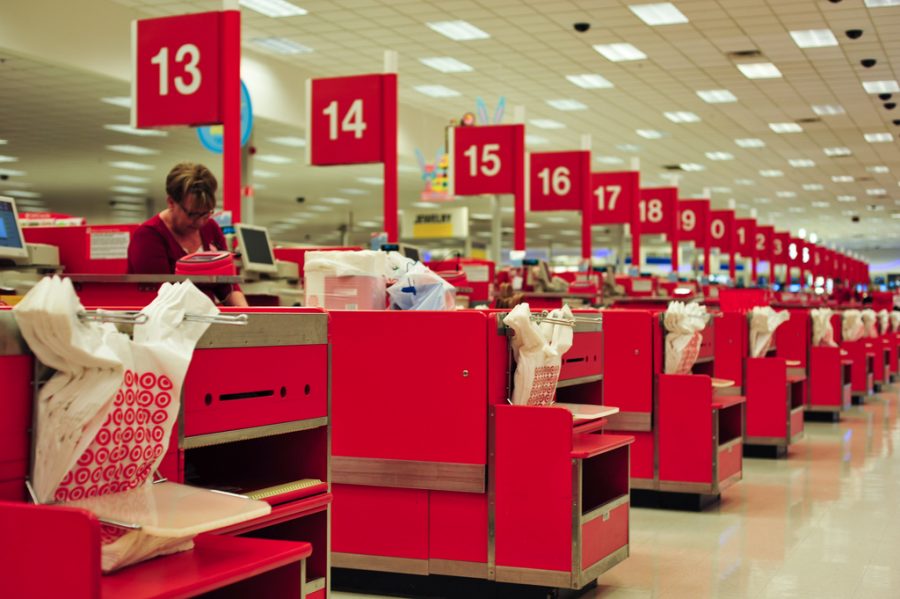Self checkout stations eliminate high school jobs
By Carolyn Gray ’19
For years, it was routine to end every shopping experience by heading to cashier, hearing the words “Did you find everything you were looking for today?”, and listening to the beeping barcode scanner as items were hauled by the conveyor. Today, shoppers are asking themselves this question as they bag, scan and purchase items for themselves through self-checkout POS stations without a cashier.
Many seasoned shoppers agree that self checkout stations make the process of purchasing goods and services simpler and swifter than ever. However, I am afraid I must be the bearer of bad news: shoppers of this mindset have been duped. Self checkout stations are not only detrimental to the jobs of retail workers, but they also take more time and money out of shoppers’ pockets and cause companies to give their workers unethical tasks.
First off, self-checkout stations have put millions of jobs on to the chopping block. According to Forbes, automation could eliminate 73 million U.S. jobs by 2030.
The possibility of the retail industry becoming obsolete is very real. . According to the Conversation, self checkout stations are projected to globally increase from 191,000 in 2013 to 325,000 in 2019. This means that Staples’ students who are looking for cashier jobs will find that getting one will be more difficult with less availability for jobs in retail.
Many customers have insisted that self-service checkout stations provide more benefits than the traditional checkout process, but this simply isn’t true. For instance, many customers believe that self-service checkouts are speedier than traditional checkout stations. This is only because customers spend time doing the work themselves at self-checkouts, instead of impatiently waiting for a cashier to do the work for them. Marketplace conducted an experiment to find out whether self-checkout stations were faster than a cashier by giving shoppers identical grocery lists and timing how long it took for each of them to checkout.
According to an article by CBC on the experiment, the cashier was able to carry out the transaction faster than the self-checkout machine and also encountered fewer problems. In one occurance, the self-checkout machine made an incorrect error with the selling price and charged the customer $70 for 10 brussels sprouts. Traditional checkout stations are not only faster, but that they can save customers the trouble of messing up the machines.
It’s not just the time of self-checkout stations that is duping customers, it’s also customers’ money. According to the Wall Street Journal, customers who used the Scan it, which is the name of Stop and Shops’ self checkout system, spent about 10 percent more than the average shopper, says to Ahold’s senior vice president for marketing and consumer insights, Erik Keptner. Keptner stated that this is because self-checkout machines make customers feel more in control of their purchase, making them more comfortable spending more money.
But at the very core of this issue, customers are not to blame for retail employees losing their jobs. Companies are more motivated to install self-service checkouts because of the savings it could bring to their business. According to a study from Diebold Nixdorf, the cost to pay retail workers can form 20 to 30 percent of a business’s payroll. For large companies that adds up to billions.
With that said, the pressure to increase companies’ profits by removing cashier jobs and replacing them with self-checkout stations has caused some businesses to make dishonorable demands of their workers. Of these companies, is the king of all superstores, Walmart, which has made their cashiers––the very people losing their jobs to self-serve terminals––ask customers to use the self-checkout stations. The megastore has demanded its cashiers “nudge” shoppers to use the self-checkout stations in order to meet the high margins of customers that the stores want going through their self-service stations.
Walmart has done what many companies have also resorted to, regardless of its ethicality. Knowing the direction that retail is headed, it seems that this will only put the time it takes employees to lose their jobs at a more accelerated pace.
The only true benefit of using self-checkouts for customers is the ability to have more control. The rest of the benefits go directly to companies instead of supporting retail workers who still need to make a living and high school students who are learning to enter the workforce.
The question customers need to ask themselves is whether it’s worth it to put millions of people out of jobs and deprive high school students of the opportunity to work a job at a checkout station just to satisfy our desire for control. Having a job outside of school can teach a young high school student valuable lessons and responsibilities.
Sadly, large companies have taken away those opportunities by desperately pushing and shoving self-service checkouts in customers’ faces. If students want to have jobs outside of school, it is up to them and other shoppers to keep checkout jobs in their control.


















































